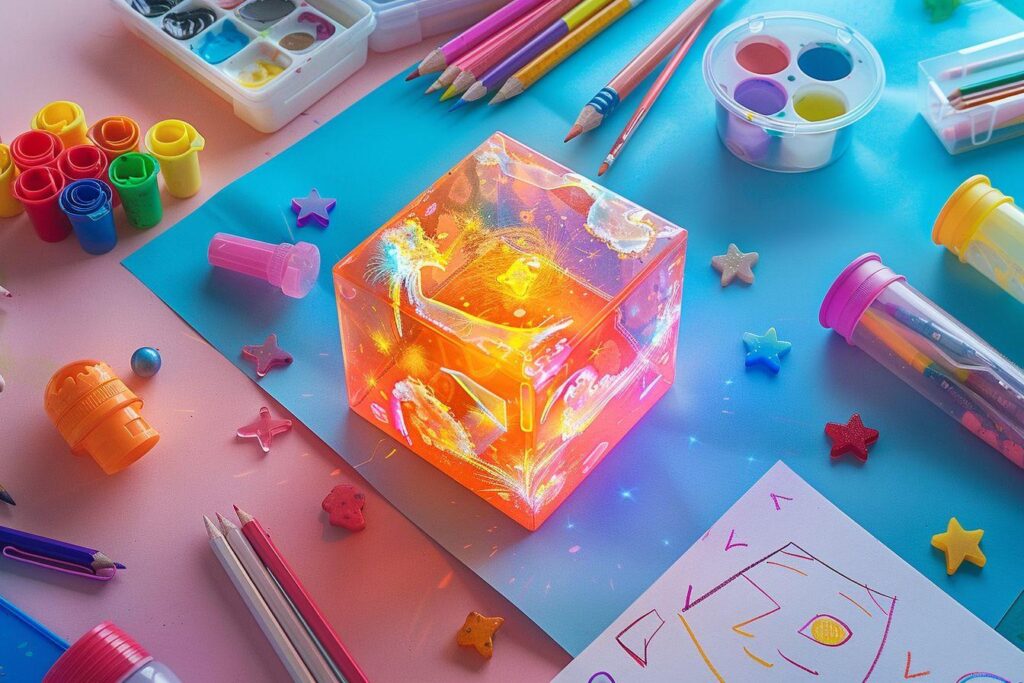The magic block has fascinated children for generations. This simple yet captivating toy stimulates their creativity and develops their motor skills. Let’s take a look at the many facets of this fun and educational object, ideal for children aged 3 to 6.
A creative toy with multiple possibilities
The magic block generally consists of three essential elements: a wax tablet, wax paper and a transparent sheet. This simple structure conceals immense creative potential. Children can draw, write or trace infinite shapes on the surface, then erase with a simple gesture to start again.
Here are just a few of the stimulating activities children can do with a magic block:
- Drawing imaginary characters
- Practise writing letters and numbers
- Create mazes for fun
- Play tic-tac-toe or mystery drawing
- Invent illustrated stories
The magic block’s versatility makes it an ideal companion for long car journeys or quiet moments at home. It stimulates children’s imagination while helping them develop fine motor skills and hand-eye coordination.
Cognitive development and playful learning
Beyond its recreational aspect, the magic block plays a crucial role in the cognitive development of young children. Using this tool, they analyze the concepts of cause and effect, permanence and deletion. These fundamental notions lay the foundations for their understanding of the world around them.
Regular use of the magic block enables children to :
- Improve their concentration and patience
- Develop their creativity and artistic expression
- Strengthen their visual and spatial memory
- Learn the basics of writing and drawing
- Learn to plan and organize their ideas
These playfully acquired skills are an excellent springboard for future academic learning. The magic block is much more than just a toy: it’s a real educational tool.

Features and choice of magic block
When choosing the ideal magic block for your child, there are several criteria to consider. Size, durability and ease of use are key elements to consider. Here’s a comparison chart to help you make your choice:
| Features | Small model | Standard model | Large model |
|---|---|---|---|
| Dimensions | 15 x 10 cm | 20 x 15 cm | 30 x 20 cm |
| Weight | 100g | 200g | 350g |
| Portability | Excellent | Good | Average |
| Drawing area | Limited | Adequate | Generous |
Choose a sturdy model with rounded edges to ensure your child’s safety. Also make sure the stylus is attached to the block to avoid losing it. Some magic blocks offer additional features such as pre-cut shapes or color zones, opening up new creative possibilities.
Alternatives and complements to the magic block
While the magic block is an excellent creative tool, there are other options for stimulating children’s imaginations. Magic coloring books, for example, offer a similar experience, with pre-printed patterns that appear when colored with a special felt-tip pen.
Other complementary activities can enrich your child’s creative experience:
- Wooden puzzles to develop logic
- Building sets to stimulate 3D creativity
- Bead kits to improve fine motor skills
- Chalkboards to vary drawing media
These alternatives make it possible to diversify activities while retaining the playful, educational aspect so important to a child’s development. Don’t hesitate to combine these different tools to offer your budding creator a rich and varied experience.
The legacy of the magic block in psychology
It’s worth noting that the magic block concept has also inspired thinking in the field of psychology. Sigmund Freud, the father of psychoanalysis, used the magic block as a metaphor to explain the workings of the psychic apparatus, particularly as regards perception and memory.
In his analysis, Freud compared the three layers of the magic block (wax tablet, wax paper and celluloid sheet) to the different psychic instances: the unconscious, the preconscious and the conscious. This analogy enabled him to illustrate how the human psyche manages to reconcile two seemingly contradictory requirements: an unlimited capacity to receive perceptions and the lasting preservation of memory traces.
Although this interpretation is a far cry from the playful use of the magic block by children, it underlines the conceptual richness of this seemingly simple object. It reminds us that even the most basic toys can have profound implications for our understanding of the world and ourselves.

